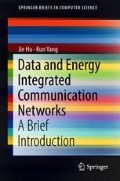Abstract
In order to address the energy shortage in communication networks, radio frequency (RF) signals are exploited for transferring energy to miniature devices, which yields wireless powered communication networks (WPCNs). A full-duplex aided hybrid-base-station (H-BS) is deployed in a WPCN for simultaneously transferring energy in the downlink and receiving data in the uplink, which may significantly increase the usage efficiency of the precious radio spectrum. User equipments (UEs) may deplete all the energy received from the H-BS for powering their own uplink transmissions. Therefore, in this full-duplex WPCN, a joint time allocation and UE scheduling algorithm is proposed for the sake of maximising the sum-uplink-throughput of multiple UEs by further considering UEs’ actual data uploading requirements. The numerical results demonstrate that the suboptimal solution is capable of achieving almost the same performance with its optimal counterpart, while our scheme outperforms other existing peers in terms of the sum-uplink-throughput.
Access this chapter
Tax calculation will be finalised at checkout
Purchases are for personal use only
Notes
- 1.
After the UE scheduling, the index of the UE, which is scheduled on the \((i+1)\)-th time slot, can also be denoted as \((i+1)\).
References
H. Ju, R. Zhang, Throughput maximization in wireless powered communication networks, in 2013 IEEE Global Communications Conference (GLOBECOM) (2013), pp. 4086–4091
R. Xie, F.R. Yu, H. Ji, Y. Li, Energy-efficient resource allocation for heterogeneous cognitive radio networks with femtocells. IEEE Trans. Wirel. Commun. 11(11), 3910–3920 (2012)
K. Yang, Q. Yu, S. Leng, B. Fan, F. Wu, Data and energy integrated communication networks for wireless big data. IEEE Access 4, 713–723 (2016)
H. Ju, E. Oh, D. Hong, Improving efficiency of resource usage in two-hop full duplex relay systems based on resource sharing and interference cancellation. IEEE Trans. Wirel. Commun. 8(8), 3933–3938 (2009)
D. Nguyen, L.N. Tran, P. Pirinen, M. Latva-aho, Precoding for full duplex multiuser MIMO systems: spectral and energy efficiency maximization. IEEE Trans. Signal Process. 61(16), 4038–4050 (2013)
Z. Zheng, L. Song, D. Niyato, Z. Han, Resource allocation in wireless powered relay networks: a bargaining game approach. IEEE Trans. Veh. Technol. PP(99), 1 (2016)
D.S. Michalopoulos, H.A. Suraweera, R. Schober, Relay selection for simultaneous information transmission and wireless energy transfer: a tradeoff perspective. IEEE J. Sel. Areas Commun. 33(8), 1578–1594 (2015)
X. Kang, C.K. Ho, S. Sun, Full-duplex wireless-powered communication network with energy causality. IEEE Trans. Wirel. Commun. 14(10), 5539–5551 (2015)
H. Ju, R. Zhang, Optimal resource allocation in full-duplex wireless-powered communication network. IEEE Trans. Commun. 62(10), 3528–3540 (2014)
X. Xia, G. Wu, S. Fang, S. Li, SINR or SLNR: in successive user scheduling in MU-MIMO broadcast channel with finite rate feedback, in 2010 International Conference on Communications and Mobile Computing (CMC), vol. 2 (2010), pp. 383–387
Y. Cui, V.K.N. Lau, Y. Wu, Delay-aware BS discontinuous transmission control and user scheduling for energy harvesting downlink coordinated mimo systems. IEEE Trans. Signal Process. 60(7), 3786–3795 (2012)
H.W. Kuhn, The Hungarian method for the assignment problem. Naval Res. Logist. (NRL) 52(1), 7–21 (2005). https://doi.org/10.1002/nav.20053
Harold W. Kuhn, Statement for naval research logistics. Naval Res. Logist. (NRL) 52(1), 6 (2005). https://doi.org/10.1002/nav.20057
Author information
Authors and Affiliations
Corresponding author
Rights and permissions
Copyright information
© 2018 The Author(s), under exclusive license to Springer Nature Singapore Pte Ltd., part of Springer Nature
About this chapter
Cite this chapter
Hu, J., Yang, K. (2018). Joint Time Allocation and User Scheduling in a Full-Duplex Aided Multi-user DEIN. In: Data and Energy Integrated Communication Networks. SpringerBriefs in Computer Science. Springer, Singapore. https://doi.org/10.1007/978-981-13-0116-2_4
Download citation
DOI: https://doi.org/10.1007/978-981-13-0116-2_4
Published:
Publisher Name: Springer, Singapore
Print ISBN: 978-981-13-0115-5
Online ISBN: 978-981-13-0116-2
eBook Packages: Computer ScienceComputer Science (R0)

